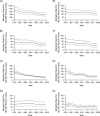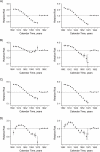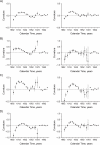How does socioeconomic development affect risk of mortality? An age-period-cohort analysis from a recently transitioned population in China
- PMID: 20042438
- PMCID: PMC3291084
- DOI: 10.1093/aje/kwp378
How does socioeconomic development affect risk of mortality? An age-period-cohort analysis from a recently transitioned population in China
Abstract
During the 20th century, the Hong Kong Chinese population experienced 2 abrupt but temporally distinct macroenvironmental changes: The transition from essentially preindustrial living conditions to a rapidly developing economy through mass migration in the late 1940s was followed by the emergence of an infant and childhood adiposity epidemic in the 1960s. The authors aimed to delineate the effects of these 2 aspects of economic development on mortality, thus providing a sentinel for other rapidly developing economies. Sex-specific Poisson models were used to estimate effects of age, calendar period, and birth cohort on Hong Kong adult mortality between 1976 and 2005. All-cause and cause-specific mortality, including mortality from ischemic heart disease (IHD), cardiovascular disease excluding IHD, lung cancer, other cancers, and respiratory disease, were considered. Male mortality from IHD and female mortality from other cancers increased with birth into a more economically developed environment. Cardiovascular disease mortality increased with birth after the start of the infant and childhood adiposity epidemic, particularly for men. Macroenvironmental changes associated with economic development had sex-specific effects over the life course, probably originating in early life. The full population health consequences of these changes are unlikely to manifest until persons who have spent their early lives in such environments reach an age at which they become vulnerable to chronic diseases.
Figures





References
-
- Yusuf S, Reddy S, Ounpuu S, et al. Global burden of cardiovascular diseases. Part I: general considerations, the epidemiologic transition, risk factors, and impact of urbanization. Circulation. 2001;104(22):2746–2753. - PubMed
-
- Maddison A. Paris, France: Organisation for Economic Co-operation and Development; 2001. The World Economy: A Millennial Perspective. (OECD Development Centre Studies)
-
- Vaughan TD, Dwyer DJ. Some aspects of postwar population growth in Hong Kong. Econ Geogr. 1966;42:37–51.
-
- Chang KSF, Lee MMC, Low WD, et al. Standards of height and weight of Southern Chinese children. Far East Med J. 1965;1(3):101–109.

